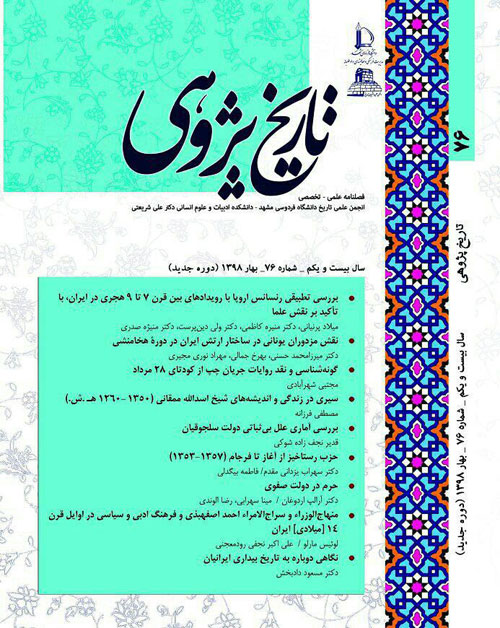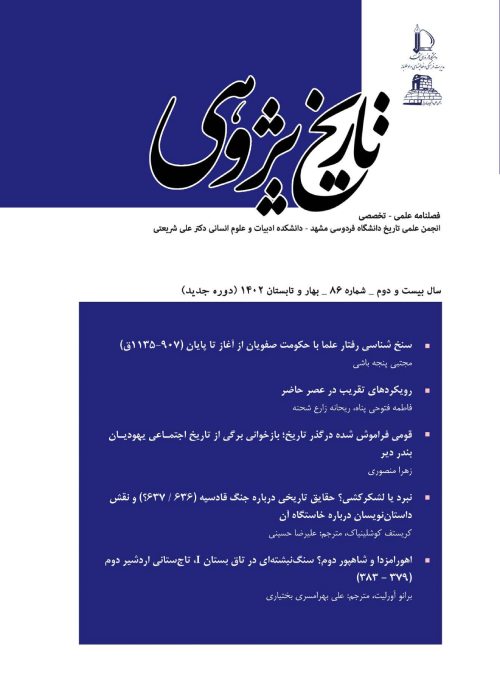فهرست مطالب

نشریه تاریخ پژوهی
پیاپی 76 (بهار 1398)
- 262 صفحه،
- تاریخ انتشار: 1398/02/14
- تعداد عناوین: 9
-
صفحات 119-141
-
صفحات 143-177
-
صفحات 179-202
-
صفحات 237-259
-
Pages 7-30Occurrence of special events by religious authorities and Muslim scientists during the 7th and 9th century of Hejra is an evidence of heterodox and altruism thoughts emergence that, in some cases, was in conformity to European history events during the Renaissance. In the recent study, we emphasized on the role of religious stimuli in advancing or stopping the Renaissance. Therefore, this question may be aroused that what are the differences and similarities between these sociocultural events (especially during Ilkhani and Taimuri government) and western cases and why there is no significant achievement. Research conclusion shows that there is significant relationship between short term socialization of Iran and short term Renaissance in this country and despite of religious authorities’ efforts, there is no achievement. Therefore, the goal of the research to evaluate this conformity is based on determination of the causes of said failures and discovery of sociocultural movement gaps during Iran history. In this research, descriptive-analytical method is used.Keywords: religious authorities, Renaissance, west, compromise, humanism
-
Pages 31-59xOne of the features of Iran army during Achaemenid era was being multinational, and almost representatives of all residents of Achaemenid borders, even out of borders, were present in Achaemenid army, especially Greek mercenaries. According to warlike morality and unfavorable economic conditions, Greek mercenaries turned to be mercenary to enjoy wage, premium and other related privileges to mercenaries and the traditional armies used them due to their high skills and efficiency in war and advanced weapons. Some researchers believe that the presence of foreign mercenaries in army was one of the causes of Achaemenid government collapse, because using foreign mercenaries in country army is in conflict to country security requirements. The army is country security support and has access to confidential military information. With powerful kingship, the army is a crucial element to achieve victory, but with the emergence of weak kingship, said army would be the cause of nonalignment and failure. At one hand, foreign forces have not bravery morality and patriotism and at the other hand, gradual development of Achaemenid was dependent on foreign forces. With attention to said issues, Achaemenid army was one of the influential armies due to structure, warfare instrument and tactics and affected the next government armies of the ancient Iran. This research is conducted using historical descriptive–analytical approach emphasizing on remained resources with the goal of evaluating quality of formation and entrance of Greek mercenaries to Achaemenid army.Keywords: mercenary forces, army, Greek, Achaemenid
-
Pages 61-92From Iranian viewpoint, the 28th Mordad coup has been the manifestation of unbelievable and great failure with long term effects on Iranian community mindset, and the related debates and opinions to it have been continued until now. Meanwhile, what has occupied the Iranian mind more than others is to find who are liable against this failure. During the said time, leftists were the most powerful political party as we can say the mass party was the basic symbol of leftists who were belonged to Iranian organized and real party that influenced political condition despite of illegal structure. According to this view point that mass party had been faced with various challenges due to Iran’s national movement, evaluation of Iran mass party role during Iran’s national movement had been the subject of various debates. Iranian leftists had provided various narratives of their role during this time that followed special type of chronology. Unfortunately, instead of solving problems related to the role of mass party in national movement failure, the conflicts had been intensified due to the narratives. In this research, it is attempted to comparatively evaluate leftists’ narratives, typology and important cases.Keywords: leftists, mass party, national movement, the 28th Mordad Coup
-
Pages 93-117One of the influential periods of Iran history was the constitutionalism era. During this time, various practitioners were included consisting of various persons from religious authorities to liberals. One of the influential practitioners was Shaikh Asadollah Mamaghani. He was a religious clergyman who occupied various formal positions and experienced different events from the constitutionalism to the 28th Mordad coup. He was one of the statesmen who had significant position in religion science and combined two conflicting dimensions of religion and politics together. It is necessary to mention that there is no independent research to evaluate various dimensions of his role and thoughts in the politics and his position as political clergyman in Iran history. In fact, there are dispersed researches. The recent paper is an effort to evaluate political-social activities and thoughts of Shaikh Asadollah Mamaghani during one of the influential era of Iran history as the constitutionalism period to Pahlavi dynasty. The research is conducted as descriptive-analytical based on library methodology.Keywords: Mamaghani, constitutionalism, assembly, religious authorities, religion, government, Saadat committee
-
Pages 119-141Due to military strength and territory extent, Seljukian government is one of the greatest governments of Iran history after Islam. Nevertheless, by Nezamolmolk murder and MalekShah death, Seljukian government declined, political instability began, and after the third Toghrol murder by Kharazm Shahian, the government collapsed. According to this point that the early overthrow and the weakness of Seljukian was the result of political instability, the evaluation and identification of origination and intensification related factors are very important in this historical era. The recent paper is an effort to respond to this question: what is the relationship between three indices of age of king when he was introduced as the king, age of king at death date and Seljuki kingship duration and political instability? To respond to this question, the author performed statistical analysis of indices as king age, date of king death and Seljuki kingship duration. The author’s statistical analysis shows that there is a positive correlation between kingship beginning at youth and long term kingship and political stability during the said historical era.Keywords: Seljukian, political non-stability, age of king at beginning ofkingship, age of king at date of death, kingship duration
-
Pages 143-177Mohammad Reza Shah decided to dissolve official political parties as “Mardom”, “Mellion” and “Iran Novin” in 1974 to prevent political, economic and social crises and continue his successor kingdom based on establishment of unit and overall party. Finally, he established Rastakhiz party as a base to stabilize kingdom system situation, the constitutional law and the white revolution achievements. This research methodology is descriptive-analytical, and to gather data, library and documentary methods were used. Due to the type of establishment, membership and activities of Rastakhiz party, this party was introduced as the symbol of king dictatorship within 2 to 3 years. The said party had been established to introduce the political base of kingship system, but had been criticized, and with the revolutionary movement development, people expressed their hate to it, and finally there was no solution unless its dissolution in September 1978.Keywords: Mohammad Reza Shah, Mardom Party, Mellion Party, IranNovin Party, Rastakhiz Party
-
Pages 237-259The history of Iran's awakening, by Nazem al-Islam Kermani, is an important book about the events surrounding the Iranian constitutional revolution. Mirza Muhammad Nazem al-Islam introduced the 3rd volume of the book, which describes the events that led to the Constitutional Revolution, during his lifetime. The fourth and fifth volume of the book was also compiled and written by Saeedi Sirjani many years after his death. He collected and edited Nazem al-Islam's handwritten writings in the era of minor tyranny (which never found the opportunity to publish them) and after correction. The issue that arises here is to what extent Nazem al-Islam's accuracy and integrity in the description of his events have been and how much of these writings are derived from personal effects and influenced by the political and social conditions of those times in the field of writing. Is it? In this research, an attempt has been made to study the book of Iranian Awakening with a descriptive-analytical method. Using the documents and other available library resources about the events related to the constitutional Revolution of Iran, its accuracy, honesty and influence are discussed. To be caught. The results of this research indicate that Nazem al-Islam Kermani, in some cases, has entered personal intentions and desires, and sometimes, according to the political and social conditions, ignored some historical facts or reversed the title has done. However, one can not ignore the importance of the book in the history of the constitutional era and ignore the detailed and rich information in the book.Keywords: Awakening history of Iranians, Nazim al-Islam, Constitutionalrevolution, Minor tyranny


